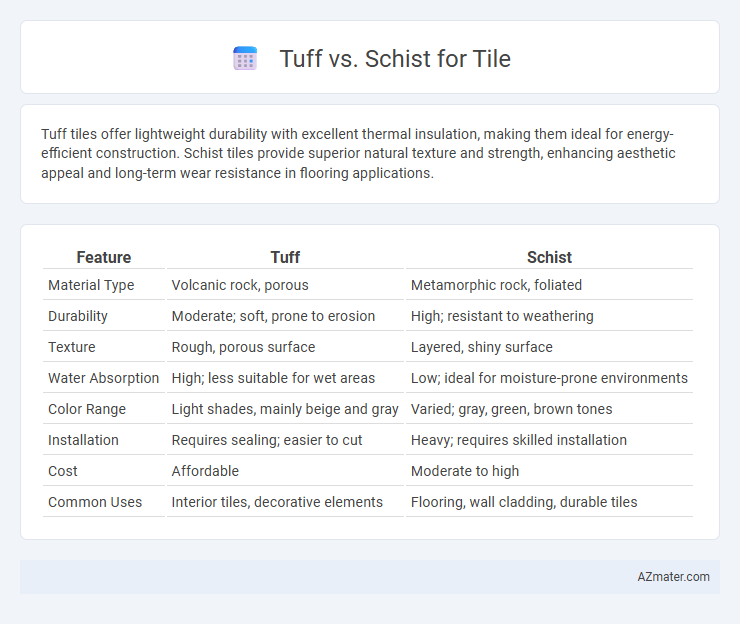Tuff tiles offer lightweight durability with excellent thermal insulation, making them ideal for energy-efficient construction. Schist tiles provide superior natural texture and strength, enhancing aesthetic appeal and long-term wear resistance in flooring applications.
Table of Comparison
| Feature | Tuff | Schist |
|---|---|---|
| Material Type | Volcanic rock, porous | Metamorphic rock, foliated |
| Durability | Moderate; soft, prone to erosion | High; resistant to weathering |
| Texture | Rough, porous surface | Layered, shiny surface |
| Water Absorption | High; less suitable for wet areas | Low; ideal for moisture-prone environments |
| Color Range | Light shades, mainly beige and gray | Varied; gray, green, brown tones |
| Installation | Requires sealing; easier to cut | Heavy; requires skilled installation |
| Cost | Affordable | Moderate to high |
| Common Uses | Interior tiles, decorative elements | Flooring, wall cladding, durable tiles |
Introduction to Tuff and Schist Tiles
Tuff tiles are crafted from volcanic ash compacted over time, resulting in a porous, lightweight stone that offers excellent thermal insulation and natural slip resistance. Schist tiles originate from metamorphic rock rich in mica, providing a durable surface with a distinctive layered texture and shimmering appearance. Both materials offer unique aesthetic and functional qualities, making them popular choices for indoor and outdoor flooring applications.
Geological Formation of Tuff vs Schist
Tuff forms from volcanic ash ejected during explosive eruptions, which later compacts and solidifies into a porous, lightweight rock, often characterized by its pyroclastic origin. Schist, in contrast, is a metamorphic rock created through intense heat and pressure that recrystallize pre-existing sedimentary or igneous rocks, resulting in a foliated texture rich in mica minerals. The fundamental difference in geological formation impacts their durability and appearance, with tuff's volcanic origin providing a softer, more porous material compared to the dense, layered structure of schist.
Visual Appearance and Texture Differences
Tuff offers a porous, lightweight texture with natural pitting and a matte finish, creating a rustic, earthy appearance ideal for casual or Mediterranean-style tiles. Schist features a foliated, crystalline texture with visible mineral flakes and a slightly reflective surface, providing a more sophisticated and layered aesthetic suited for elegant, high-end tile applications. The visual contrast between tuff's soft, muted tones and schist's shimmering, textured layers defines their distinct appeal in tile design.
Durability and Strength Comparison
Tuff is a volcanic rock known for its lightweight and porous structure, which makes it less durable and more prone to wear under heavy traffic compared to dense schist. Schist, a foliated metamorphic rock, offers superior strength and resistance to chipping or cracking, making it ideal for high-traffic tile applications. The higher mica content in schist enhances its tensile strength and durability, providing a longer lifespan for flooring and wall tiles.
Porosity and Water Absorption Rates
Tuff exhibits lower porosity and water absorption rates compared to schist, making it more suitable for areas prone to moisture exposure. Schist's higher porosity increases its susceptibility to water damage and staining over time. Selecting tuff for tile applications enhances durability and moisture resistance, crucial for both indoor and outdoor installations.
Slip Resistance and Safety
Tuff offers a naturally rough texture that provides excellent slip resistance, making it a safer option for wet or high-traffic areas compared to schist. Schist tends to have a smoother, more polished finish, which can increase the risk of slipping, especially when wet. Choosing tuff tiles enhances safety by reducing slip hazards in both residential and commercial environments.
Installation Challenges and Best Practices
Tuff's porous and softer nature requires careful handling during installation to prevent cracking and chipping, making surface preparation and the use of flexible adhesives critical for durability. Schist, with its foliated texture and variable thickness, demands precise cutting and leveling techniques to ensure a flat, stable tile layout and proper grout application. Best practices include moisturizing tuff tiles before installation to reduce dust and using waterproof sealants on schist to protect against moisture infiltration and staining.
Maintenance Requirements for Each Stone
Tuff requires minimal maintenance due to its porous nature, necessitating regular sealing to prevent staining and water absorption. Schist, with its foliated texture, demands more frequent cleaning and resealing to maintain its durability and prevent flaking or delamination. Proper maintenance of both stones ensures longevity and preserves their natural aesthetic in tile applications.
Cost Considerations and Budgeting
Tuff tiles generally offer a more budget-friendly option compared to schist, with costs typically ranging from $3 to $7 per square foot, while schist tiles can cost between $10 and $20 per square foot due to their durability and unique texture. Installation expenses for both materials vary based on labor rates and tile thickness, but schist often requires more careful handling, increasing labor costs by up to 20%. Factoring in long-term maintenance and replacement frequency, tuff may present lower initial investment costs, whereas schist provides greater longevity, impacting overall budgeting decisions for tile projects.
Best Applications: Indoor vs Outdoor Uses
Tuff offers superior durability and weather resistance, making it ideal for outdoor applications like patios and garden pathways where natural stone must withstand elements. Schist's layered texture and aesthetic appeal suit indoor environments such as kitchens and living areas, providing a warm, decorative surface requiring less exposure to harsh conditions. Both stones excel in slip resistance, but tuff's porosity and strength favor outdoor use while schist's intricate patterns enhance indoor design.

Infographic: Tuff vs Schist for Tile
 azmater.com
azmater.com